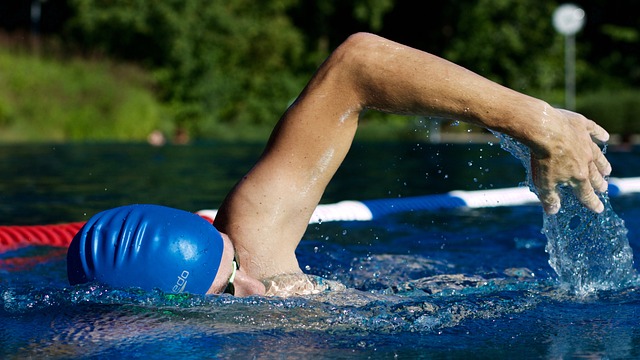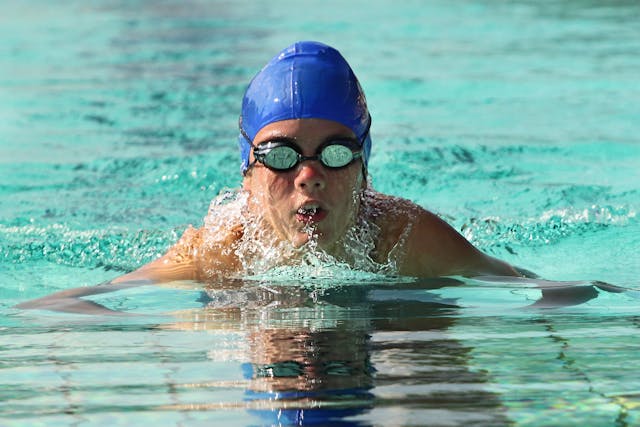Swimming is a valuable life skill that offers both fun and fitness, plus numerous physical, mental, and emotional advantages, but knowing where to start can be really challenging.

In this tutorial, we’ll guide you through the basics of “how to swim” for beginners, covering techniques like the butterfly stroke and freestyle breathing. Whether you’re asking, “How can I swim?” or looking to learn how to swim faster, this guide will help.
Adults can discover methods on how to learn to swim, and parents will find tips on how to teach an infant to swim. Dive in and explore everything from fundamental strokes to advanced swimming techniques.
1. Get comfortable in water
The first step in learning to swim is getting comfortable in the water. Spend some time in a shallow area where you can touch the bottom and gradually acclimate yourself to being submerged.
Practice floating on your back and stomach, focusing on relaxation and buoyancy.
2. Breathing control
Practice rhythmic breathing by exhaling slowly through your nose or mouth while your face is submerged and inhaling quickly when you turn your head to breathe.
Start by practicing this technique while standing in shallow water and gradually progress to floating and swimming.
3. Basic floating
Lie on your stomach or back with your arms extended slightly outward and your legs relaxed. Keep your body horizontal and allow yourself to float effortlessly on the water’s surface.
Practice breathing and relaxation while floating to build confidence and stability in water.
Video Tutorial
4. Flutter kick
The flutter kick is a fundamental skill in swimming that propels you through the water. Begin by holding onto the pool edge or using a kickboard for support.
Keep your legs straight but relaxed and kick from your hips, not your knees. Practice kicking gently and steadily, focusing on maintaining a consistent rhythm and propulsion.
5. Arm movements
Once you’re comfortable with floating and kicking, it’s time to add arm movements to your swim strokes. Start with the freestyle stroke, also known as the front crawl.
Extend one arm forward while the other arm pulls through the water in a circular motion. Alternate your arms and coordinate your breathing to propel yourself forward smoothly.
6. Practise more
Like any skill, learning to swim requires practice and repetition. Set aside dedicated time for swimming regularly, whether it’s in a pool, lake, or ocean.
Consider taking swimming lessons from a certified instructor to receive personalized guidance and feedback on your progress.
Follow Nekius
visit Nekius Shop
nekius
Safety Precautions while swimming
1. Supervision
Never swim alone, especially in open water. Always swim in designated swimming areas supervised by lifeguards whenever possible. Children should always be closely supervised by a responsible adult while swimming.
2. Do not exceed limits
Be aware of your swimming abilities and never push yourself beyond your comfort level. Avoid swimming in deep or rough waters if you’re not a confident swimmer. Pay attention to warning signs and advisories issued by lifeguards or local authorities.
3. Respect the environment
Swim in areas where it’s safe and legal to do so. Avoid swimming in polluted or contaminated waters, as they can pose health risks. Respect wildlife and refrain from disturbing marine life while swimming in natural bodies of water.
4. Wear proper gear
Obtain high-quality swimwear and goggles that provides comfort and mobility in the water. If swimming in open water, consider wearing a brightly colored swim cap or flotation device to enhance visibility and safety.

5. Stay hydrated
Swimming can be physically demanding, so it’s essential to stay hydrated before, during, and after your swim. Drink plenty of water to prevent dehydration and maintain optimal performance in the water.
6. Learn water safety skills
Familiarize yourself with basic water safety skills, such as treading water, floating, and rescuing techniques. Knowing how to respond in emergency situations can save lives and prevent accidents while swimming.
The Advantages of Swimming
1. Physical Fitness
Swimming is a highly effective full-body workout that engages multiple muscle groups simultaneously. It improves cardiovascular health, builds muscular strength and endurance, and enhances flexibility and coordination.
Regular swimming can help maintain a healthy weight, reduce the risk of chronic diseases, and improve overall fitness levels.
2. Mental Well-being
Swimming is not only beneficial for the body but also for the mind. The rhythmic motion of swimming has a calming effect on the nervous system, reducing stress, anxiety, and tension.
Immersion in water promotes relaxation and mindfulness, allowing swimmers to disconnect from the outside world and focus on the present moment.
3. Lifesaving Skill
Learning to swim is a crucial lifesaving skill that can prevent drowning accidents and water-related emergencies.
In addition to self-preservation, knowing how to swim enables individuals to assist others in distress, potentially saving lives in emergency situations.
4. Social Engagement
Whether participating in swim clubs, aquatic fitness classes, or recreational swimming events, swimming provides opportunities to connect with others who share a passion for the water.
5. Lifelong Enjoyment
Unlike many sports and physical activities, swimming is accessible to people of all ages and abilities.
Whether you’re a child splashing in the pool, an adult lap swimmer, or a senior enjoying aquatic therapy, swimming offers lifelong enjoyment and fulfillment for individuals of diverse backgrounds and interests.
Swimming is more than just a recreational activity, it’s a valuable life skill that offers a myriad of physical, mental, and social benefits. By mastering the basics of swimming, adhering to safety precautions, and recognizing the importance of this skill, individuals can dive into the waters with confidence.

